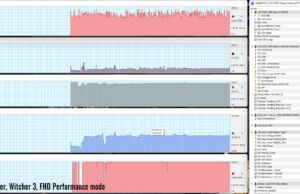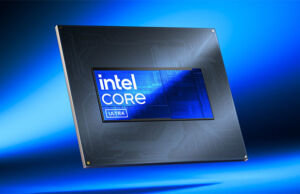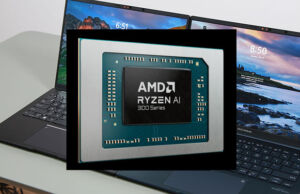The AMD Radeon 680M is the much-awaited top-tier RDNA2-based integrated GPU bundled with the majority of the 2022 AMD Ryzen 6000 Rembrandt processors.
In this review article, we’re taking a deep look at this iGPU’s performance in benchmarks, as well as at its overall capabilities in workloads and games. We’re also going to compare it with a couple of other similar-tier GPU solutions, including the Vega-based iGPU in the previous Ryzen 5000 hardware, the Iris Xe iGPU in the Intel 12th gen Alder Lake and 11th gen Tiger Lake platforms, as well as some entry-level Nvidia RTX 3050Ti Max-Q dGPU implementations.
Update: If interested, here’s our review of the more recent AMD Radeon 780M iGPU chip, based on the AMD RDNA3 architecture.
Our results are based on the AMD Ryzen 9 6900HS processor in the Asus ROG Zephyrus G14, where we disabled the dGPU to be able to test the iGPU in all sorts of loads.
It’s important to understand that the G14 hardware implementation provides more than sufficient power and cooling capacity for a Ryzen-only configuration, and is indicative of the maximum performance you can expect from the Radeon 680M iGPU. Implementations without the same thermal design, especially the ultra-portable Ryzen U/H ultraportable formats that will be available this year, might not be able to perform the same way, due to various power/thermal limitations.
That’s why I’ve run some tests at a few different power settings, in order to better understand how the 680M is going to perform in an ultraportable and power-limited implementation. I also recommend going through detailed reviews for a more in-depth analysis of what each unit can do.
I’ll also mention that there are two AMD Radeon 600M RNDA2-based iGPUs with the current AMD generation, and this article goes over the top-tier Radeon 680M option, bundled with the Ryzen 7 and Ryzen 9 6000 processors. We’ll also follow up on the Radeon 660M bundled with the Ryzen 5 6000 CPUs in a separate article at a later date, once we get to properly test that as well.
I’ve listed the specs sheets for both RDNA2 chips down below, next to the previous-gen Vega 8 chip.
| Graphics | Radeon 680M | Radeon 660M | Radeon Vega 8 |
| Architecture | RNDA2 – Rembrandt | RNDA2 – Rembrandt | Vega – Cezanne |
| Compute Units | 12 | 6 | 8 |
| Shaders | 768 | 384 | 512 |
| Graphics Speed | up to 2.4 GHz | up to 1.9 GHz | up to 2.0 GHz |
| Processing Power (FP32) | 3.68 TFLOPs | 1.45 TFLOPs | 2.05 TFLOPs |
| Integrated on | Ryzen 9 6900HX, HS Ryzen 7 6800H, HS, U and lower Ryzen 7 |
Ryzen 5 5600H, HS, U | Ryzen 7 and 9, 5000 U, HS, H |
Based on these alone, the 680M seems to be a significant update of the 2021 Vega 8 iGPU, while the 660M is clearly a more budget implementation with less than half of its processing power.
AMD Radeon 680M (RDNA2) benchmarks
With that in mind, let’s go over some benchmark results first:
| Radeon 680M, on Zeph G14 2022, 50+W power |
Radeon 680M, on Zeph G14 2022, 25W power limit |
Vega 8, on Zeph G14 2021 |
Vega 8, on Yoga S 7 Pro |
Iris Xe, on 12th-gen i9 H |
Iris Xe, on 11th-gen i7 H |
RTX 3050Ti MQ, on XPS 15 |
|
| 3DMark- Time Spy Graphics | 2481 | 2021 | 1177 | 1225 | 1648 | 1609 | 4273 |
| 3DMark- Fire Strike Graphics | 7071 | 6195 | 3435 | 3788 | 5655 | 5348 | 11572 |
| 3DMark- Night Raid Graphics | 30595 | 25839 | 15185 | 16725 | 22460 | 20359 | – |
| Passmark 10 – 3D Graphics | 2994 | – | 2285 | 2509 | – | 3380 | 10127 |
| Uniengine Superposition, 1080p Medium |
4801 | 4056 | 2275 | 2539 | 3228 | 3122 | 7587 |
| Uniengine Superposition, 1080p Extreme |
1503 | 1271 | 671 | 754 | 1087 | 1066 | 2437 |
When provided with 50+ W of CPU package power, the AMD Radeon 680M iGPU is more or less twice as fast as the previous AMD Vega 8 chip found in the 2021 Ryzen Cezanne hardware.
However, in a power-limited 25W implementation, which is indicative of what we could expect in a potential ultraportable Ryzen design this year, the results drop by 20+%. Of course, the CPU scores will drop as well with the power-limited design, but that’s a topic for a different article.
Compared to the Iris Xe chip in the 12th and 11th gen Intel processors, the Radeon 680M ends up scoring ~50% higher in 3Dmark and Superposition, but trails the Intel iGPU in the Passmark test. The Intel iGPU runs at maximum potential in the M16 design, and at about 95% of its potential in the slightly power-limited ZenBook 14X implementation.
Finally, none of these integrated iGPUs are a proper match for even an entry-level Max-Q dGPU such as the RTX 3050Ti in the XPS 15. The Radeon 680M is roughly 60% of its performance.
Further comparison with the older GTX 1650 MQ chips and the base-level Nvidia MX450 and MX550 chips would make sense here, but we don’t have any recent tests for a proper analysis. I’ll update once we get to test those.
Moving further, let’s dive into some real-life workloads that would utilize the GPU to some amount, such as image/video editing in Adobe Photoshop and Premiere, as well as various other workloads part of the Specviewperf suite of tests.
| Radeon 680M, on Zeph G14 2022, 50+W power |
Radeon 680M, on Zeph G14 2022, 25+W power |
Vega 8, on Zeph G14 2021 |
Vega 8, on Yoga S 7 Pro |
Iris Xe, on 12th-gen i9 H |
RTX 3050Ti MQ, on XPS 15 |
|
| Puget – Photoshop | 1049 | – | 750 | – | 1114 | 725 |
| Puget – Premiere | 366 | – | 193 | – | 500 | 621 |
| SPECvieperf 2020 – 3DSMax | 32.89 | 27.76 | 15.22 | 16.26 | 15.39 | 54.38 |
| SPECvieperf 2020 – Catia | 20.73 | 17.53 | 11.63 | 12.48 | 14.73 | 30.12 |
| SPECvieperf 2020 – Maya | 87.03 | 75.8 | 46.8 | 51.35 | 57.51 | 171.42 |
| SPECvieperf 2020 – Solidworks | 43.26 | 39.32 | 21.82 | 26.13 | – | 100.88 |
Photoshop is primarily a single-core CPU-heavy load, so not something you should weigh in heavily in this GPU test. Premiere, on the other hand, utilizes the iGPUs and gives a significant edge to the Iris Xe chip thanks to supporting Intel’s QuickSync technology, so editing videos in Premiere is going to be faster than on a Radeon 680M configuration. I haven’t tested DaVinci Resolve to see how the two platforms fare in that aplication.
For everything else, when supplied with enough power (50+ W), the newer AMD iGPU is 1.6 to 2x the performance of the Vega 8, and 1.3 to 1.5x of the Iris Xe Intel implementation. In a power-limited 25W design, though, the performance drops by 10-20%, but even in this case, the 680M outmatches the full-power Vega 8 and Iris Xe units by a major margin.
AMD Radeon 680M (RDNA2) gaming performance
Next, let’s look into some games.
Here’s what we got on Medium settings at FHD+ resolution (FHD for the G14, as FHD+ is not an option). I’ve added two RTX 3050Ti MQ configurations, for comparison. The Radeon 680M was tested at max power, and we’ll also touch on the power limited profiles down below.
| Medium settings | Zephyrus G14 2022 – R9 + Radeon 680M FHD+ resolution |
Zephyrus G14 2021 – R9 + Vega 8 FHD resolution |
Zephyrus M16 – Core i9 + Iris Xe FHD+ resolution |
XPS 15 – Core i7 + 3050Ti 35+W FHD+ resolution |
VivoBook Pro 14X – Ryzen 7 + 3050Ti 35+W FHD+ resolution |
| Far Cry 5 (DX 11, Normal Preset, TAA) |
43 fps (38 fps – 1% low) | 23 fps (20 fps – 1% low) | 31 fps (27 fps – 1% low) | 72 fps (54 fps – 1% low) | 76 fps (44 fps – 1% low) |
| Shadow of Tomb Raider (DX 12, Medium Preset. TAA) |
35 fps (24 fps – 1% low) | 22 fps (16 fps – 1% low) | 26 fps (20 fps – 1% low) | 52 fps (26 fps – 1% low) | 66 fps (52 fps – 1% low) |
| The Witcher 3: Wild Hunt (DX 11, Medium Preset, Hairworks Low) |
47 fps (34 fps – 1% low) | 25 fps (20 fps – 1% low) | 35 fps (23 fps – 1% low) | 92 fps (59 fps – 1% low) | 98 fps (73 fps – 1% low) |
With most games, the Radeon 680M delivers almost 2x the framerates of the previous Vega 8 chip, both in the Zephyrus G14 chassis. We’re also looking at ~30-50% higher-framerates versus the Iris Xe chip in the Zephyrus M16.
Of course, keep in mind there’s always a potential margin of error to consider here, as these results are measured on devices that are not primarily meant to run on the iGPUs. Thus, better-optimized drivers might provide higher framerates on the iGPU-only configurations.
What I didn’t get to test on this unit is FidelityFX/RSR performance for the Radeon 680M chip. For what is worth, AMD’s materials suggest up to 50% higher framerates with RSR enabled in compatible titles such as Battlefield 5, Doom Eternal, or Cyberpunk.
These aside, here are a couple more games and FHD resolution and Low graphics settings, compared to a handful of other iGPU platforms from AMD and Intel.
| Low settings | Zephyrus G14, R9 6900HS + R 680M 50+W, FHD 1080p |
Zephyrus G14, R9 6900HS + R 680M 25+W, FHD 1080p |
Zephyrus G14, R9 5900HS + Vega 8 45+W, FHD 1080p |
Zephyrus M16, i9 12900H + Iris Xe 45+W, FHD 1080p |
Yoga Slim 7 Pro, R7 5800H + Vega 8 45+W, FHD 1080p |
ZenBook 14X, i7-1165G7 + Iris Xe 30+W, FHD 1080p |
| Bioshock Infinite (DX 11, Low Preset) | 117 fps (74 fps – 1% low) | 105 fps (62 fps – 1% low) | 87 fps (67 fps – 1% low) | 92 fps (62 fps – 1% low) | 87 fps (59 fps – 1% low) | 89 fps (38 fps – 1% low) |
| Dota 2 (DX 11, Best Looking Preset) | 96 fps (66 fps – 1% low) | – | 68 fps (54 fps – 1% low) | 79 fps (63 fps – 1% low) | 62 fps (48 fps – 1% low) | 76 fps (56 fps – 1% low) |
| Far Cry 5 (DX 11, Low Preset, no AA) | 53 fps (47 fps – 1% low) | 39 fps (33 fps – 1% low) | 27 fps (24 fps – 1% low) | 38 fps (33 fps – 1% low) | 28 fps (22 fps – 1% low) | 34 fps (22 fps – 1% low) |
| Far Cry 6 (DX 12, Low Preset, no AA) | 48 fps (35 fps – 1% low) | – | – | crashed | – | – |
| Shadow of Tomb Raider (DX12, Lowest Preset, no AA) | 67 fps (42 fps – 1% low) | – | 35 fps (31 fps – 1% low) | 43 fps (30 fps – 1% low) | 37 fps (31 fps – 1% low) | 45 fps (29 fps – 1% low) |
| The Witcher 3: Wild Hunt (DX 11, Low Preset, Hairworks Off) | 55 fps (43 fps – 1% low) | 45 fps (32 fps – 1% low) | 27 fps (20 fps – 1% low) | 43 fps (26 fps – 1% low) | 26 fps (20 fps – 1% low) | 44 fps (23 fps – 1% low) |
The results are all in favor of the Radeon 680M chip, but the gains vary in percentage between the older and the more recent and more demanding titles.
One other aspect that I wanted to clarify is that all these platforms tested above are able to deliver maximum sustained performance on the AMD/Intel iGPUs, with the minimal exception being the lower-powered ZenBook 14X implementation, as in that case the Iris Xe chip only runs at about 95% of its potential. Here are some logs provided as evidence.
All in all, the RDNA2-based iGPU looks like the most powerful iGPU technology available as of early-2022. That’s going to be especially important for ultraportable thin-and-light devices without any sort of dGPU. However, it’s crucial to understand that those would require a competent thermal module capable of at least 50W of sustained CPU-package power in order to provide the Radeon 680M iGPU with the power required to run at full load, at its maximum frequency of 2.4 GHz, as in our tests.
That’s illustrated in the benchmarks sections above, and I’ve also tested the GPU’s behavior in games at a couple of other power settings. Here’s what we got:
- 40W limit – iGPU runs ~2.2 GHz (3-7% real-life performance decrease);
- 30W limit – iGPU runs ~1.75 GHz (15+% real-life performance decrease);
- 25W limit – iGPU runs ~1.5 GHz (20+% real-life performance decrease).
At 25W, in Far Cry 5, the recorded framerates drop to 39 fps (33 fps – 1% low), down from 53 fps (47 fps – 1% low) at 50+W of power. With Witcher 3, we got 45 fps (32 fps – 1% low), down from 55 fps (43 fps – 1% low) at 50+W.
Realistically, most ultraportables won’t go above 30W, and the ultrathin ones might even struggle to deliver 25W sustained. So what I’m saying is that not all of the RDNA2-based Radeon 680M AMD ultraportables will be able to deliver the performance numbers illustrated in this article. In fact, the majority will not.
Of course, what we have here is a Ryzen 9 6900HS implementation, and these findings might differ a bit for the Ryzen 7 6800U ultra-efficiency platforms. However, based on our past experience, I wouldn’t expect major differences, as the Ryzen U and HS are the same architecture and should behave similarly at matching power settings.
Update: If interested, here’s our review of the more recent AMD Radeon 780M iGPU chip, based on the AMD RDNA3 architecture.
Ok, at this point that’s about it for this AMD Radeon 680M iGPU performance analysis. Looking for your feedback down below, as well as questions on anything else that you might be interested in testing.


















Emil
March 1, 2022 at 7:17 pm
How much power did the Intel Xe IGPU in the M16 draw?
Andrei Girbea
March 1, 2022 at 7:24 pm
On Turbo, the i9 runs at 70W sustained in combined loads in the M16: https://www.ultrabookreview.com/wp-content/uploads/2022/03/gaming-turbo-igpu-irisXE-farcry.jpg . I haven't tested the Intel configuration in a power-limited setting. You'll find some details in the ROG Flow Z13 review, though
Emil
March 1, 2022 at 7:46 pm
Thanks. I still can't tell how much better the RDNA2 iGPU will be compared to Intel's Xe iGPU in a ultra portable thin and light 25-30W laptop will be ^^. Right now it's just a best case scenario with the G14 and people who'll buy this laptop will use the dGPU instead. The last gaming test shows a 10-30% improvement for the G14 restricted with a 25W TDP over the Zenbook 14x in a 30W TDP and also a (LP)DDR4 memory speed.
Hope all journalists and reviewers will get the chance to test a near similar system with both Intel's 12th gen and AMD's 6000 series APU 😆
Andrei Girbea
March 1, 2022 at 8:05 pm
You're not going to find many i9-12900Hs at 25-30W, this is why I haven't included a power-limited profile for the M16. In comparison, the 6800U that will be available in portable devices is very similar in specs and architecture to the 6900HS tested here, hence the 25W limitation of the 6900HS is a good indication of the 6800U's performance at that power. I hope this makes sense.
Our review of the ZenBook 14X is a pretty good starting point for the kind of performance you can expect on an Intel Xe implementation at around 30W of power. 12th gen Iris Xe should not be different than 11th gen.
JJ
March 2, 2022 at 10:54 am
Thank you for the overview, very detailed! Still a bit disappointing because in some leaks, it said 2700 in timespy (with not optimized drivers). Do you think we will see better scores in the next months (e.g. through driver optimization)?
Andrei Girbea
March 2, 2022 at 11:32 am
we might.
Pablo
March 2, 2022 at 3:24 pm
Did you happen to run any tests on battery? I’m curious about gaming on the G14 on battery with the dGPU disabled. Performance and battery life. That’s the one use case I could see wanting to use the iGPU over the dGPU.
Andrei Girbea
March 2, 2022 at 3:33 pm
No, I haven't run any games on battery on the iGPU. That's a good question, but I no longer have this unit around for further tests
Kurt
March 2, 2022 at 7:03 pm
Thank you. Seems like gaming performance is worse than last gen MX450 mobile for whatever reason. (Witcher 3 1080p Medium – 47fps vs 59fps, according to notebookcheck.net/The-Witcher-3-Notebook-Benchmarks.143187.0.html
Curious to see how 6800U's 680M compares to 25W MX550 and 35W RTX3050 Max-Q on a smaller Ultrabook.
Andrei Girbea
March 2, 2022 at 7:14 pm
Careful about that. Witcher 3 doesn't have an inbuilt benchmark and our benchmark sequence differs from NBCs. It's best to compare games with a standard benchmark inbuilt tool, such as Shadow of Tomb, Far Cry, or Bioshock. However, I wouldn't be surprised to see a proper MX450 implementation outmatching the 680M.
I don't have recent tests for the MX450. The 3050TI MQ results are relevant for a small computer, because the XPS 15 is a power-limited design.
Worth mentioning that 6800U designs are most likely going to be smaller than something that would allow a 15-20W CPU + any sort of dGPU. So a fair comparison would be with a Ryzen/Intel + MX550 10W, if that's going to be available (should be given there were 10 and 25W versions of the MX450).
Kurt
March 3, 2022 at 3:55 am
Really good to know, thanks for the info!
Ondrej
March 6, 2022 at 4:40 pm
What i would find very appealing is to be able to fully power the APU with just the USBC charger while maintaining high level of performace playing games.
Right now it doesnt seem like this would be a great idea for the battery.
Andrei Girbea
March 7, 2022 at 11:07 am
I haven't tested it. Might be doable, since Silent dGPU mode on USB-C doesn't take much out of the battery. I don't really understand why you'd want to play games on the iGPU on a G14 though.
pepipo
March 8, 2022 at 6:48 am
Thank you so much for this detailed article, by reading the news i thought it was possible to get a thin laptop with the hyped performance of the 680M, but for that you need an H series CPU, no U model will be +30W, so the difference between Iris Xe and 6800U is not really much, the real jump would be 6800H but usually these models come with a dGPU, the only-iGPU models are hard to find in stock and usually come late, i guess +8 months more: yoga pro, thinkbook 14p, ideapad pro
sofia
June 1, 2022 at 6:44 am
Hello and thanks for the review
Do you think rx 680m can be enough to work with premiere, illustrator and after effects software (up to 4k)? Or should I go for cheap options like rtx 2050?
Thanks
Andrei Girbea
June 1, 2022 at 9:23 am
I would rather look into an Intel 12th-gen laptop for Adobe software. Not sure how much an RTX 2050 would help, but I expect it to outmatch the 680M by a fair bit.
You haven't specified what kind of laptop you're looking at, but AMD options without a dGPU are hardly available now, and that might not change for a while
Christoph
June 15, 2022 at 4:35 pm
What about the Rog Flow X13 2022 edition with AMD Ryzen 7 6800HS and the 680M? Would it cope with 4k Video Editing?
Andrei Girbea
June 16, 2022 at 11:53 am
see this article: https://www.ultrabookreview.com/54774-asus-rog-flow-x13-680m-xgmobile/
Victor
November 12, 2022 at 6:49 pm
Is it possible to get better performance on 680M disabling turbo con CPU cores?
Andrei Girbea
November 14, 2022 at 3:11 pm
No, especially in designs that allow sufficient power for the GPU to work at full speeds, as the ones tested here.
Rafa
January 28, 2023 at 2:47 pm
What about the transcoding capabilities? How many transcodes is this new 680m vs the quick sync of Intel?
Thanks
Mmick
February 11, 2023 at 10:23 am
It is quite fine that the evolution gives us low end dGPU power on a iGPU. I love it!
I have a Surface Pro 8 that has an Iris Xe and I also have an eGPU (Razor X thunderbolt eGPU box with a rtx 3060ti) and it's marvelous.
At the moment I tried several games with the Xe and things I couldn't on my other laptop (uhd 620) because they were at 5-7 fps, now they run at 20-25 fps or even better; and when I really want demanding games or settings, I plug in the eGPU and it flies. All that with the sabe SP8.
I think people should invest more on those solutions.
Victor
February 13, 2023 at 10:33 pm
Agree, for more demanding games an eGPU is required. But for the majority of them an iGPU is perfect!
Currently I have an Acer (i5 7300 + GTX 1050) but I'm tired to carry 2.3kg… I'm waiting the reviews of the new 780M (RDNA3), performance could be close to the GTX 1650.
Ross Kingston
January 4, 2024 at 10:18 am
Will this chipset support ray tracing in minecraft?